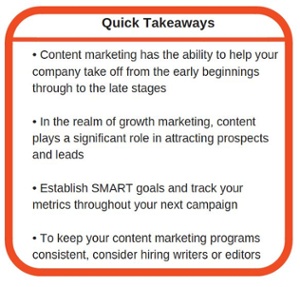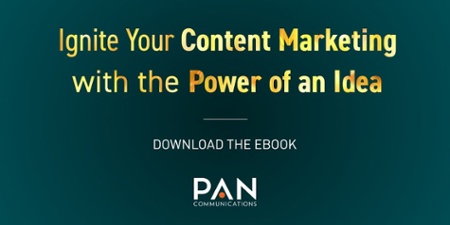Launching a B2B tech or healthcare brand from the ground up isn’t easy. It takes years of dedication and persistence. Once you’ve finally begun to create a digital footprint, you’ll soon realize you need more than a website to fuel growth – you’re going to need content that educates, informs, and engages.
 The foundation for this will be your content marketing strategy.
The foundation for this will be your content marketing strategy.
Content marketing is critical to any business, with nearly 74% of businesses seeing an increase in their content marketing budget. However, only 21% of marketers consider their content marketing successful compared to their competitors.
As a growing brand, you know that having a strategy is critical to success. Just as there are multiple steps to funding your startup, there are corresponding content marketing initiatives.
In this post, we’re sharing the approach for each stage of development. These are as follows:
- Early stage: building a content hub
- Mid-stage: continuous content that connects
- Late stage: doing it all in scale with advanced metrics and technology
In short, your website needs to become a full-scale publisher of regular, quality content that is not only relevant to your audience, but also consistent in its message. With each stage, you should build upon the previously set foundation until your content marketing runs like a well-oiled machine.

Why Content Marketing Is Key to Your Brand’s Success
In the realm of growth marketing, content plays a significant role in attracting prospects and leads. If executed well, it should offer value to your audience and increase your credibility. Here are the key factors that make content marketing a must.
Establishing Trust
As an early stage company, your brand is relatively unknown. To become known, you’ll need content that answers questions and provides insights. It should be a story about how you can address your customer’s needs, not a commercial for your brand.
Budget-Friendly Alternative to Traditional Marketing
Your marketing budget may be slim to none, but when you look at cost and return, you’ll find that content marketing performs much better than commercials or print ads. Plus, it’s much easier to track actual returns on your content marketing efforts.
Want more on integrated marketing for B2B tech brands? Read, ‘Defining Your B2B Tech Integrated Communications Strategy’.
Expanding Reach
Content marketing gets your brand out into the digital world. It exposes your prospects to your expertise, especially on social media or via web search. This is the “attraction” of content marketing.
Where to Start?
Next, we’ll look at three specific phases and the tactics that coincide with them. However, you’ll need to have a few things settled before you begin creating content.
Define Your Target Buyer
Developing your personas is critical. You need to know who your audience is and what motivates and influences them. You also need to understand where they are online, so you can get your content in front of them. This allows you to develop content that is relevant to their goals.
You must know who your primary and secondary audience is. This will help you identify how to write and create your content in a manner that solves their needs.

Logistics You Need for Your Content Marketing Foundation
Before any content is developed, there are several other areas that need to be addressed so that your strategy has the best chance of success.
First and foremost, you must define your goals with content marketing. Along with developing SMART goals, you will need to determine how you will track and measure efforts. SMART ensures that goals are specific, measurable, attainable, relevant, and timely. For example, a SMART content marketing goal could be a 20% increase in blog views within six months.
Next, you need to determine how content will get distributed—via email, social media, guest sites, newsletters, third-party sites, etc.
Now, it’s time to look at each stage.
Early Stage: Building a Content Hub
How can you build a content hub with lots of content assets and little to no budget? That’s a rational concern, but there are ways to build your hub as you build your company.
In the early stages, the most important content you’re producing should outline the solution(s) your product or service provides.
With your limited budget in mind, use these tips to begin building this hub of content:
- Use Google docs to share and collaborate
- Develop a content calendar with publishing dates and themes
- Repurpose content. If you wrote a blog, try summarizing it in an infographic or explainer video. Having different formats related to the same topic can also help you determine what type of content your audience responds to best.
- Use free tools to distribute the content. For example, most social media management apps are helpful (and free of charge in some cases).
- Report variations of content on other publishing sites like Medium, Quora or LinkedIn. This will also set you up with backlinks back to your site.
In this first stage, you are hoarding content and preparing your website to become a publishing machine, while defining other channels for consistent, continuous content distribution.
Middle Stage: Content That Connects
In this stage of content marketing growth, it’s all about creating gated content that is compelling and original. Gated content means that the eBook or whitepaper is available to a user if they provide contact information like an email address – this kind of content more closely supports lead generation. This requires the creation not only of the actual asset, but also of a landing page from where it can be downloaded by users.
Take the information that you’ve gathered from these leads and potential prospects to update your buyer personas. At this stage, your personas should be even more refined. Keep referring to them and honing a message that will resonate with them.
Elaborate on your personas’ pain points in conjunction with content that resonates, channels with the most engagement and channels of entry from your discovered metrics. These insights allow you to further tailor your content and messaging.

At the middle stage, your brand equity should have increased to a point at which your ideal audience already carries some impression of your brand. You may also have more of a budget now to build leads with high-conversion content. However, the content should still be educational in nature and add value to the user’s day-to-day experience. If it doesn’t, you won’t receive the desired results.
With your new budget, you could choose to promote your content on a social media platform, where you can target users with specific attributes and characteristics. You can perform some simple tests at this point that are very affordable. Spend more if you see positive results.
You should also have a gated content offer connected to your homepage. The homepage is often the first place users land. Keep visitors on your site longer and possibly get their email address by having an educational eBook or whitepaper they can download.
Late Stage: Scaling & Advanced Features
At this point in your growth strategy, you should be starting to see the impact of your content marketing efforts. A caution though, be patient—content marketing success doesn’t happen overnight. You still need to be ready to scale your strategies so that content continues to be produced.
Your strategy includes building out a content theme. Part of this theme should include the Voice of the Customer. Acknowledge the fact that you have customers that are advocates of your brand and create awareness around these relationships with content via Q&As, videos, case studies, etc.
To keep your content marketing programs consistent, consider hiring writers or editors to constantly be adding new blog posts or revising pages to better correspond with keywords or customer demands. By now, you should have content analytics identifying what’s working and what’s not.
It’s also time to invite sophisticated technology into the conversation. Technology allows you to do so much more with your content. Firstly, use AI to personalize the content, discovering what your customers are looking at or buying.
Second, marketing automation is another technology to consider. This allows you to set-up auto-responders when people complete a form. Further, email drip campaigns can be created to continue to “touch” this prospect.
Growing brands have the ability to be very flexible across a lot of disciplines, including marketing. When considering where to put your efforts, content marketing is an excellent option. It has the ability to help your company take off from the early beginnings through to the late stages.
It always helps to work with experts who have done this before. Emerging growth companies in the B2B tech and healthcare spaces are relying on integrated marketing and PR agencies for their insight and best practices when it comes to content marketing.
Uncover more content marketing strategies by downloading PAN’s recent eBook Ignite Your Content Marketing with the Power of an Idea.




